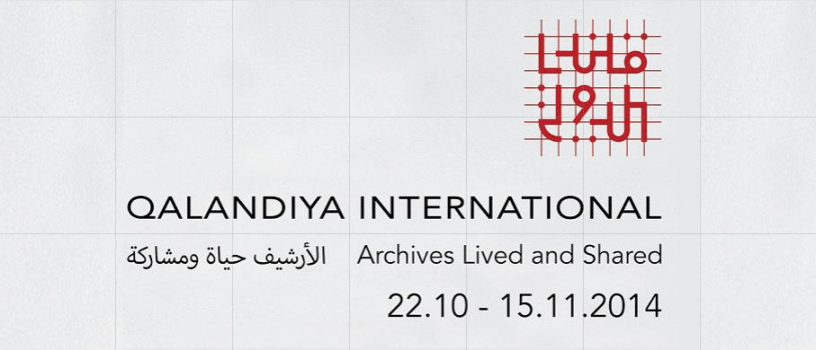Qalandiya. It is the site of the infamous checkpoint that divides Jerusalem from its northern neighbour, the city of Ramallah. It is also the designation of Palestine’s biennial art fair, Qalandiya International 2014, a showcase of contemporary Palestinian art as much as it is a show of Palestinian resilience, strength, and determination. QI 2014 will present the work of around 100 Palestinian and international artists, designers, and filmmakers, from 22 October 2014 through 15 November 2015.
“A spirit of collective creative resistance”
Qalandiya International 2014 [QI 2014], the second edition of Palestine’s biennial art fair nearly didn’t happen this year. But it was the recent devastation in Gaza that inspired QI organisers this summer, in a measure of “defiance to this horrific destruction intended to cripple life and continuity”, to go ahead with the programme of commissions, projects, and exhibitions. “Archives Lived and Shared“, is the theme for QI 2014, focusing on “the role of archives in shaping Palestine’s past and present”.
And more to the point, in order to get to Qalandiya International and experience Palestinian contemporary art for yourself (whether you’re a native or from another country altogether), at some point in your visit, you’ll have to go through this:
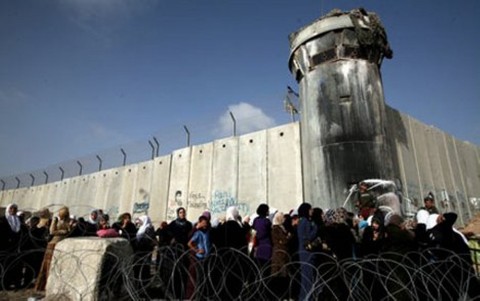
Qalandiya, an up-and-coming biennial fair of contemporary art…is also a Palestinian refugee camp established in 1949 between Jerusalem and Ramallah, in a village that has been under military occupation since 1967. And it is one of the most stringent checkpoints in the West Bank.
This is the name chosen for Qalandiya International, which in 2012 became an ambitious attempt through art to bridge “a fragmented geography” and engender opportunities for artists from Palestine, as well as from elsewhere, to show their work on an international scale. Moreover, for the fair’s organisers, QI “aims to engage the local public in programs not straitjacketed by realpolitik and allow them to look at art in a more imaginative and open manner.”
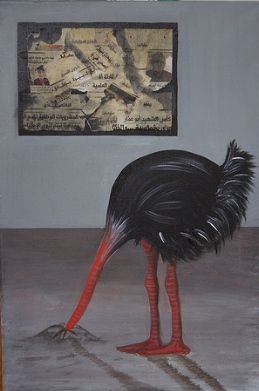
Palestine, a site of conflict and extraordinarily rich culture
The first Qalandiya International was in 2012 in the first weeks of November, hosting around 60 artists in 10 cities around West Bank as well as in several Palestinian cities in Israel. Jennifer Higgie, co-editor of Frieze magazine, wrote a frank and revealing article about her attendance of QI and covered the first several days of the inaugural fair. The article begins with the point that “Palestine isn’t just a site of terrible and ongoing conflict; it’s also a region that is extraordinarily rich in culture.” She seems to find the environment equally engaging as the art she encountered in her visit, and took care to highlight “the humour, resilience and lack of self-pity encountered amongst Palestinians who live with a situation that most would find intolerable.”
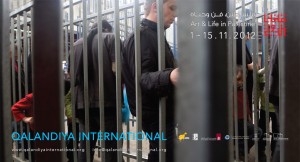
By Higgie’s coverage of her experience of QI (from checkpoints to exhibition spaces through to depictions of the art itself), it is abundantly clear and imperative to remember that one may not be able to consider this art separately from its context, that of where and under what conditions the work is made. It is a context in which, as Higgie explains, people are surrounded by “the Wall [that] has infected many an imagination” and inspires works such as Khaled Jarrar’s concrete objects (a soccer ball, a ping pong paddle, a Buddy Bear), or Majd Abdel Hamid’s hourglasses, both artefacts made by first chipping bits from the West Bank Barrier, thus conceptually and physically providing the base material for these sculptures.
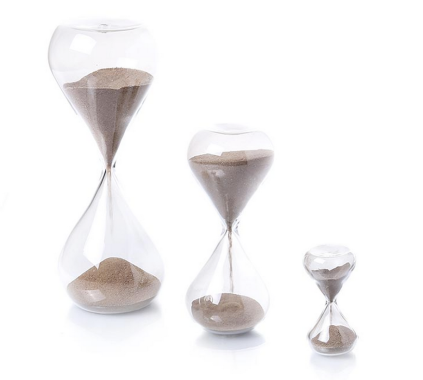
Of course, not all the work at QI is about The Wall but this well-known man-made monstrosity that snakes along 700 km and cuts people off from farms, health care, education, and family is hard to dismiss, as it is part of daily life for Palestinians.
Displacement, memory, and dispossession are among other themes starkly ever-present in Palestinian art, such as in Wafa Hourani’s “Qalandia 2067”, revealing a dystopic future for Qalandiya on the centennial of its occupation, and could very well depict the village today.
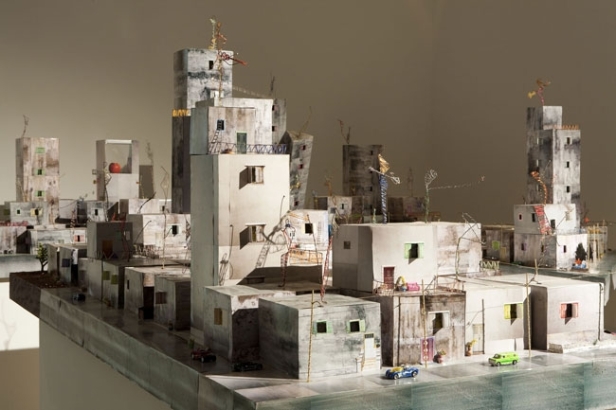
And now, Palestine’s biennial is back with more contemporary art
Two years after the inaugural fair, Qalandiya International has grown to around 100 artists, mostly Palestinian, with a number of international artists also commissioned for projects. The biennial is comprised of events, exhibitions, performances, and symposia in West Bank cities starting with Qalandiya (the fair’s namesake), and includes many key cities in the area, such as Ramallah, Al-Bireh, Abu-dis, Birzeit, and Jerusalem.
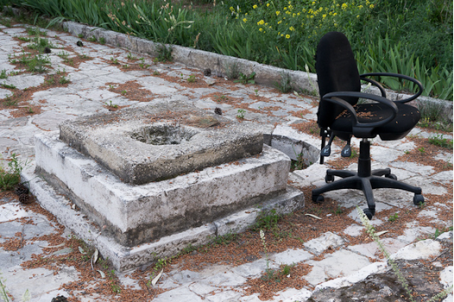
Though separated by distance and physical barriers, Gaza joins QI with a project called “Gaza 87” supported by Eltiqa Group and Windows for Contemporary Art. Those also outside the Wall are not to be excluded either; the city of Haifa on the Mediterranean shore hosts “Manam [Dream]”, an exhibition supported by the Arab Cultural Association and Al-Mashghal Arab Centre for Culture and Arts.

In all, 12 institutions partnered up to establish Qalandiya International, including these 10 in Palestine’s West Bank and Gaza:
Al-Ma’mal Foundation (Jerusalem); the A. M. Qattan Foundation (Ramallah, Gaza); Arab Culture Association (Haifa); International Academy of Art Palestine (Al-Bireh/Ramallah); Khalil Sakakini Cultural Centre (Ramallah); Palestinian Art Court – Al Hoash (Jerusalem); Ramallah Municipality; Riwaq (Al-Bireh/Ramallah); and the Palestinian Museum (Birzeit), and Iltiqa Group for Contemporary Art (Gaza)
Plus these two organisations, based in UK and Israel:
MinRASY PROJECTS (London) and Al-Mashghal/Arab Centre for Culture and Arts (Haifa).
Probably it’s clear by now that guests would be hard-pressed to see everything at this art fair, even if it seems to be in an area roughly the size of Venice Biennale, with a tenth the number of exhibitions, and lasting three weeks. As I hinted in the beginning of this article, Qalandiya International’s raison d’etre is in its very existence, with the irony that any visitors, especially the locals, will have to be very determined to get there in the first place.
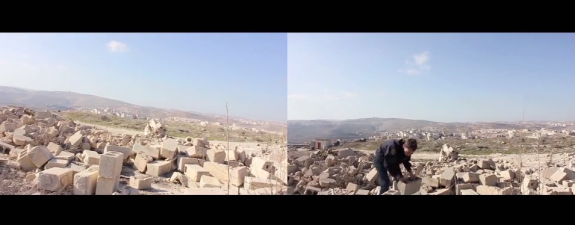
Personally, I can’t wait to see QI for myself and more importantly, I want to share what I find there, so click the Follow button on this page or the social media button(s) below the post. In the upcoming weeks, I’ll include overviews of the Young Artists of the Year (AM Qattan Foundation), Disarming Design collective (Ramallah), and a few other exhibitions/events, after which, I’ll share a summary of my own experience of Qalandiya International. Until next time!
More links and information
- Read more about Qalandiya International – 22 October through 15 November 2014 – includes programme of events, list of exhibitions, artist information and more.
- View/Download Qalandiya International 2014 – opening week programme [PDF]
- Preview of QI 2014: “An event promoting culture in Palestine” by Rafique Gangat for Gulfnews.com – 11 September 2014 – “stitching together the fragmented geography of Palestine to forge an identity…Arts and culture as a means to resist the occupation has shown that strength lies in unity”
- Preview of Qalandiya International 2014 by James Scarborough for Huffington Post – 11/10/2014 – “[Qalandiya International] demonstrates how artists and cultural institutions can create a mosaic of solidarity across a occupation-decimated country. It aims to engage viewers, to get them to look at art as something not just documentary but living, useful, and hopeful.”
- Read about Qalandiya International on Biennial Foundation website – “the culmination of the vision of seven Palestinian cultural institutions focused on contemporary art and the Palestine cultural landscape”
- Review of Qalandiya International 2012 by Jennifer Higgie for blog.Frieze.com – 21 November 2012 – “Palestine…is a region that is extraordinarily rich in culture. Countless individuals and organizations are working hard… to promote and encourage non-violent forms of creative conflict resolution, from re-building villages to putting on exhibitions.”
- Review of QI 2012 – “Mapping Palestinian Contemporary Art” by Ruthie Abel for Huffington Post Blog – 28 January 2013
- Related blog post by Anna aka TumbleweedInTelAviv about the author’s first-hand experience of “Qalandiya: Checkpoint from Hell” – 13 December 2012 – “I was angry too…but everyone else was trying to get back to their lives, and they couldn’t, there was nothing they could do to just live normally, and that’s a horrible feeling, absolute no control over anything. “
- Watch a video about Eltiqa Group for Contemporary Art [YouTube, 8:36 mins] – Three Gazan artists Mohammed Al Hawajri, Raed Issa and Dina Matar on objects and memory, and home and resistance.
Event details: Qalandiya International takes place over a number of locations in Palestine and Israel from 22 October through 15 November 2014. All events open to the public. Some tours/events/film screenings require prior booking.

